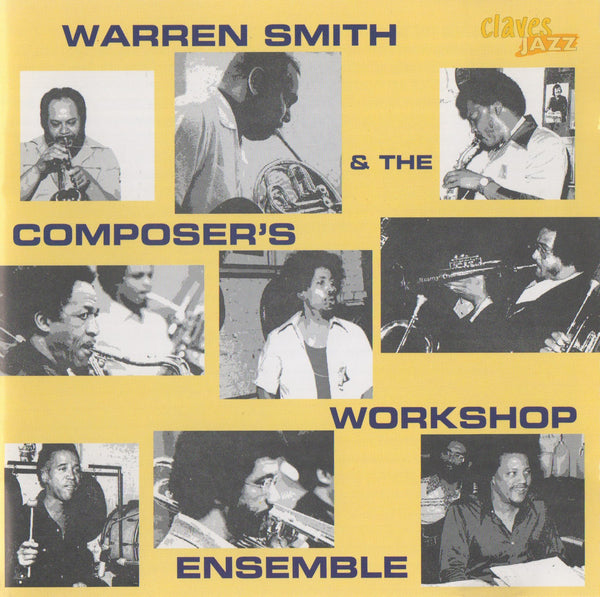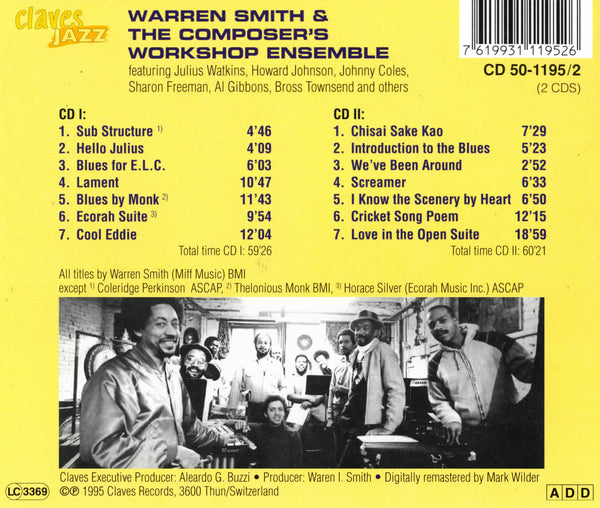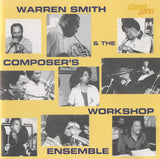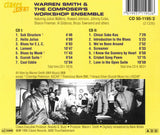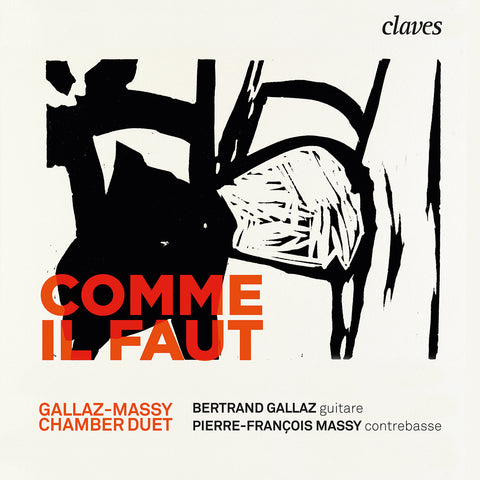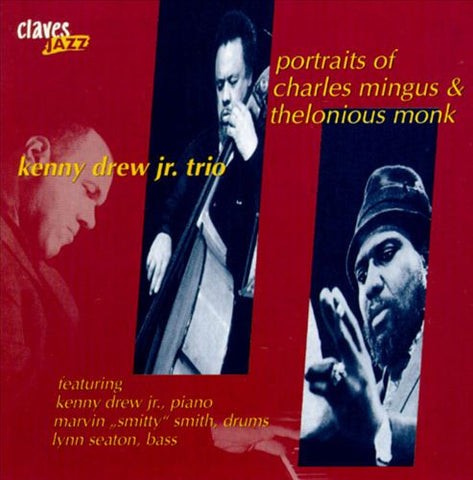(2013) Warren Smith & The Composer's Workshop Ensemble
Catégorie(s): Folklorique, populaire et Jazz Raretés
Instrument(s): Contrebasse Saxophone Trompette
Nb CD(s): 2
N° de catalogue:
CJ 1195-2
Sortie: 1995
EAN/UPC: 7619931119526
Cet album est en repressage. Précommandez-le dès maintenant à un prix spécial.
CHF 24.00
Cet album n'est plus disponible en CD.
Cet album n'est pas encore sorti. Précommandez-le dès maintenant.
CHF 24.00
Cet album n'est plus disponible en CD.
CHF 24.00
TVA incluse pour la Suisse et l'UE
Frais de port offerts
Cet album n'est plus disponible en CD.
TVA incluse pour la Suisse et l'UE
Frais de port offerts
Cet album est en repressage. Précommandez-le dès maintenant à un prix spécial.
CHF 24.00
Cet album n'est plus disponible en CD.
This album has not been released yet.
Pre-order it at a special price now.
CHF 24.00
Cet album n'est plus disponible en CD.
CHF 24.00
Cet album n'est plus disponible en CD.
NOUVEAU: Les achats se font dorénavant dans la devise de votre pays. Modifier le pays ici ou lors du checkout
WARREN SMITH & THE COMPOSER'S WORKSHOP ENSEMBLE
The ensemble’s style can be summarized as contemporary orchestral with certain characteristics from experimental jazz (sometimes referred to as Contemporary Black Art). Similarities to the Black Art of Sun Ra and the sonorities of Gil Evans can also be heard. There are, in fact, a number of connections to these two musicians, such as a periodic exchange of band members — Warren Smith, for example, frequently performed as a percussionist with Gil Evans.
Over the course of years the Composer’s Workshop Ensemble became an institution in the New York jazz scene, where experimentation could freely take place without the constraints of the popular market. The ensemble, as a rule, does not make musical concessions; its members are free to “play out" their ideas, to generate new sounds that might later take shape in everyday music.
Although the Workshop Ensemble rarely performed in concert, they did record a number of LP’S from the late 60’s to the early 80's. Two of these recordings appeared on the New York label Strata East (SE8 1972-3, SES 7422), one was recorded tor Music Company (KRS-1006), and another recording was made for Baystate, Japan (RVJ-601 3). The group also appeared as the accompanying ensemble for Van Peeples on A&M Records (SP 4161).
We are pleased to re-release the first three of these LPs (the most important, musically speaking) on these two compact discs. We are sure that you will enjoy the unmistakable, warm, orchestral sound of the ensemble, its penchant tor percussiveness and its outstanding soloists. Among the eminent soloists that appear on this recording are Howard Johnson, Jimmy Owens, Bross Townsend, George Barrow, Jack Jeffers, Garnett Brown, and the deceased Julius Watkins, the godfather of the French horn - a unique constellation which makes these recordings a must for collectors.
Warren Smith himself said of the ensemble and the recordings:
"The group started in 1960 primarily because my friends and l were frustrated by the lack of write charts and scheduled weekly rehearsals. Jack Jeffers, Coleridge Perkinson and I were the main organizers and contributors at this time. My writing consisted mainly of taking arrangements I liked (by Horace Silvers, Gerald Wilson and others) off the records and orchestrating then to fit our needs. We gave our first concert in December 1962 at the Carnegie Recital Hall. Since that time, we’ve managed to perform at least once each year in concert. Thus the title: “We’ve been around”.
“The Composer Workshop Ensemble was organized to create an outlet for a group of musicians to perform non-commercial music. The group is dedicated to playing compositions that perpetuate the art of Black music and also give performers a creative outlet with which to express themselves. The outlet is one rarely found on the American scene".
“My objectives are to express myself in a group concept thru musical composition and improvisation. We want to sound human with all the imperfection and beauty on a living thing. To accomplish this everyone in the band must be involved. The rhythm section must phrase, sing, harmonize, use dynamics; the horns must punch, push or hold back the motions. We try to breathe, cry, laugh and shout together, realizing that an unified effort is much more powerful than a single voice - no matter how brilliant"
Otto Flückiger (Translation: Mark Manion)
(2013) Warren Smith & The Composer's Workshop Ensemble - CJ 1195-2
The Composer’s Workshop Ensemble has been in existence since 1960. In the beginning the musicians rehearsed at the studio of well-known musicologist Dr. Leonard Goins until they moved to Warren I. Smith’s own small music studio “WIS”, which was located in an apartment building on Manhattan’s 21st Street between 7th and 8th Avenues. For years on every Sunday evening, the Composer’s Workshop Ensemble would meet here to jam. Visitors to the studio were always swept away by the tree and friendly atmosphere that ruled at these get-togethers. Years later the ensemble moved to the nearby “Chelsea Performing Arts Studio WIS" at 153 West 21st Street, where concerts also took place.
The ensemble’s style can be summarized as contemporary orchestral with certain characteristics from experimental jazz (sometimes referred to as Contemporary Black Art). Similarities to the Black Art of Sun Ra and the sonorities of Gil Evans can also be heard. There are, in fact, a number of connections to these two musicians, such as a periodic exchange of band members — Warren Smith, for example, frequently performed as a percussionist with Gil Evans.
Over the course of years the Composer’s Workshop Ensemble became an institution in the New York jazz scene, where experimentation could freely take place without the constraints of the popular market. The ensemble, as a rule, does not make musical concessions; its members are free to “play out" their ideas, to generate new sounds that might later take shape in everyday music.
Although the Workshop Ensemble rarely performed in concert, they did record a number of LP’S from the late 60’s to the early 80's. Two of these recordings appeared on the New York label Strata East (SE8 1972-3, SES 7422), one was recorded tor Music Company (KRS-1006), and another recording was made for Baystate, Japan (RVJ-601 3). The group also appeared as the accompanying ensemble for Van Peeples on A&M Records (SP 4161).
We are pleased to re-release the first three of these LPs (the most important, musically speaking) on these two compact discs. We are sure that you will enjoy the unmistakable, warm, orchestral sound of the ensemble, its penchant tor percussiveness and its outstanding soloists. Among the eminent soloists that appear on this recording are Howard Johnson, Jimmy Owens, Bross Townsend, George Barrow, Jack Jeffers, Garnett Brown, and the deceased Julius Watkins, the godfather of the French horn - a unique constellation which makes these recordings a must for collectors.
Warren Smith himself said of the ensemble and the recordings:
"The group started in 1960 primarily because my friends and l were frustrated by the lack of write charts and scheduled weekly rehearsals. Jack Jeffers, Coleridge Perkinson and I were the main organizers and contributors at this time. My writing consisted mainly of taking arrangements I liked (by Horace Silvers, Gerald Wilson and others) off the records and orchestrating then to fit our needs. We gave our first concert in December 1962 at the Carnegie Recital Hall. Since that time, we’ve managed to perform at least once each year in concert. Thus the title: “We’ve been around”.
“The Composer Workshop Ensemble was organized to create an outlet for a group of musicians to perform non-commercial music. The group is dedicated to playing compositions that perpetuate the art of Black music and also give performers a creative outlet with which to express themselves. The outlet is one rarely found on the American scene".
“My objectives are to express myself in a group concept thru musical composition and improvisation. We want to sound human with all the imperfection and beauty on a living thing. To accomplish this everyone in the band must be involved. The rhythm section must phrase, sing, harmonize, use dynamics; the horns must punch, push or hold back the motions. We try to breathe, cry, laugh and shout together, realizing that an unified effort is much more powerful than a single voice - no matter how brilliant"
Otto Flückiger (Translation: Mark Manion)
Return to the album | Main Artist: Warren Smith






